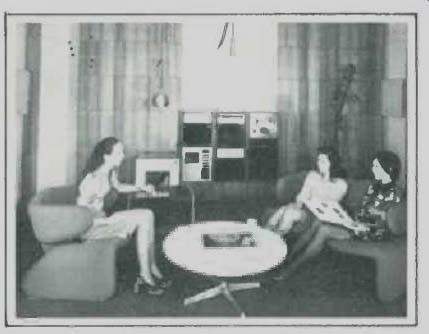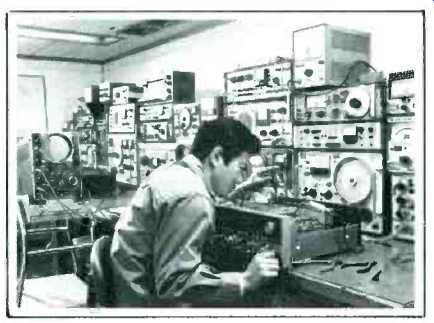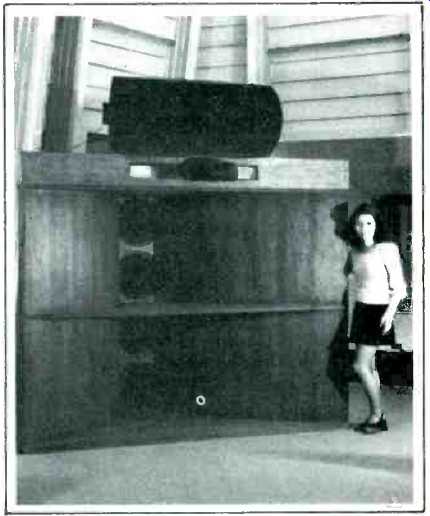
------- Research Center
The proponents of the various quadraphonic disc systems have always been co-operative, indeed anxious, to present their points of view to members of the audio press corps.
Quite naturally, each company is prejudiced in favor of its particular system and needless to say puts its best efforts forward in trying to convince us of the superiority of its system. As a consequence of this, we all have had interesting "behind the scenes" presentations on the respective merits of the CD-4 discrete system, the Sansui QS system and the EV/Columbia SQ system. Some of the demonstrations I have attended were very modest, and some quite elaborate.
Whatever the scale of effort, all of them have been helpful in clarifying many details of the quadradisc systems and in influencing our opinion of their relative worth.
Last November, JVC and Panasonic decided that it was time to thoroughly brief members of the international audio press corps on the intricacies of their CD-4 quadraphonic discrete disc system. To this end, they arranged for one of the most spectacular press junkets in hi-fi history ... a week in Japan visiting their laboratories and plants, and meeting the scientists and engineers involved with the CD-4 system. Thus on Nov. 19th the European contingent of 13 editors and writers and the 5 members of the American group descended on Tokyo. The Europeans represented audio publications in Belgium, France, Germany, Holland, Sweden and Great Britain. The American representation was Larry Klein of Stereo Review, Bill Tynan of High Fidelity. Claude Hall of Billboard, Bob Angus of Audio Times and yours truly. Bob Angus and I flew in on a 747 and after nearly I l hours from Seattle to Tokyo, we were dragging a bit. Thus we were not at our sprightliest when we stepped into a milling throng at the airport lobby, where some beaming Japanese held up JVC and Panasonic flags and banners proclaiming welcome. Next thing we knew a pretty kimona-clad girl presented us with a huge bouquet of flowers and posed with us as flashbulbs went off. Real VIP treatment! Begad, we felt like we had just returned from Tranquility Base or some such thing.
The open-handed generosity and the gracious hospitality of the Japanese are legendary. This is especially true if you are a guest of an electronics manufacturer. I had been to Japan under those circumstances a few years ago, and I knew what to expect. I think most of my companions were a bit stunned by the warmth of their reception and the overall lavishness of the entertainment laid on by our hosts. Of course we were in Japan for business too, and the next morning we had a meeting at our hotel where JVC executives introduced us to the basics of the CD-4 system. I should explain at this point that while in Tokyo we dealt mostly with JVC people, while in Osaka we were in the capable hands of Panasonic personnel. I must also note that Panasonic is the American brand name for products of Matsushita Electric Industrial Co. Ltd. In Japan, the same products are sold under the National brand name. JVC, or Victor Company of Japan, is a separate corporate entity, whose products are often in head-to-head competition with those of National/Matsushita. Yet JVC is owned by Matsushita and is part of their industrial empire. Matsushita has often been referred to as the "General Electric" of Japan. And indeed, they manufacture a tremendous range of products, from TV sets and refrigerators and other home appliances, to x-ray and other electro-medical equipment, ultra sophisticated industrial equipment, lighting equipment, and electronic gear for communications and aerospace.
And of course, they have their comprehensive line of receivers, speakers, amplifiers, tape equipment, etc. Under the "Technics" name, Matsushita markets a line of specialized very high quality audio products, which ultimately will be on the American market. JVC is more oriented to consumer electronics and has extensive lines of what we call "sets" or Consoles in this country. They also make a broad line of audio components sold in the U.S. under the JVC and Nivico brand names. The "Victor" in the corporate name refers to an affiliation with RCA Victor that began somewhere around 1911, and today Victor Company of Japan is one of the largest manufacturers of phonograph records and recorded tapes in all formats in Japan. They are also extensively involved in basic audio and acoustic research, and from these activities the CD-4 system evolved.

-------- Listening room
Well, enough of this digression and back to the activities of our group. Just after lunch on the 20th, we were taken to Victor's Aoyama Studio to observe a quadraphonic recording session and inspect the studio facilities. The studio itself is quite large ... I would estimate that a 60-70 piece orchestra could be recorded without crowding. The room was acoustically treated with both reflective and absorptive materials and forms, much in the same fashion as in studios of a few years ago in our country. The control room was equipped with a typical multi-channel mixing console, that looked as if it was a 24 input/ 16 output unit, similar to the type built by Rupert Neve for Vanguard Record Studios in New York. It had pan pot facilities, but I didn't see any "joystick" type of control for this function.
The session was being recorded on a 16-channel 3M machine, and there were 4 and 8 channel Ampexes and Scully machines in evidence. Monitor speakers were similar to Altec A-7's in the character of their sound, with perhaps a slightly heavier bass end. On the session, it was a pleasure to see some 35-40 musicians on a pop date, something increasingly more difficult to find in our studios because of the staggering recording costs. The musicians were disposed around the studio in groupings quite similar to the usual practice in U.S. studios, for quadraphonic recordings. Isolation of a particular instrument or group of instruments was via the usual gobos, distance (when possible) and close miking with cardioids. The forest of microphones featured many condenser-type Sony’s (which is to be expected) and I spotted various types of Neumann and AKG, along with some EV (looked like RE 15's) and a Shure or two. Later in the afternoon we were given a mini-tour of Tokyo, taking in the Imperial Palace grounds (from the outside!) and winding our way back to our hotel, where Victor and Matsushita hosted an elaborate "Welcome Dinner Party" for our "Audio Editorial Group", which is what the Japanese called our assemblage.

The next morning we were driven to Victor's Audio Engineering Research Center on the outskirts of Tokyo. I think it is safe to say that our group was as impressed with this magnificent installation as anything else we saw on this trip. The facilities available encompass almost every aspect of audio and acoustics. The equipment is the best available from Japan, and such things as Hewlett Packard scopes and generators, Bruel and Kjaer frequency spectrum analyzers and B&K calibrated microphones with frequency response beyond 100 kHz! Ampex 440-4 quadraphonic tape machines were used for A/B comparison of discrete four channel tapes versus the same program on the CD-4 disc. The center has one of the largest anechoic chambers in the world. The construction is the usual fiberglass wedges, with open steel mesh for flooring. The entire room floats on rubber cushioning and is essentially vibration-free. The chamber is big enough to allow frequency response testing down to 100 Hz. As an old recording man, the most fascinating facility at the center was their experimental recording studio. Since it has a stage and seating area it also doubles as an auditorium. The walls of the stage area are divided into 3 sheets, each of which can be positioned to give either a reflective or absorptive surface.
The sheets of reflecting board which make up the ceiling of the stage, can be raised or lowered or changed angularly by electricity. In the studio section, the side walls are arranged in panels in sort of "concertina", or corrugated fashion and slope inward 7 degrees from vertical. Each vertical panel is divided into six horizontal panels. At the touch of a button, these reflective panels can be raised or lowered, revealing behind them absorptive fiberglass batts. Each of the panels moves independently and allows a various "mix" acoustically so that the reverberation period of the studio ranges from 0.6 to 1.6 seconds. At each corner of the studio was an absolutely gigantic 4-way all horn loaded speaker system. When I say big ... I mean that two large types like Bob Angus and me were able to stand in the mouth of the horn! The sound was quite impressive from these brutes, but we didn't hear any music which really revealed their full capabilities. In between the speakers, on the stage, was a king-sized four-channel oscilloscope, with a screen about the size of a 25 inch TV set. Just to make things more interesting it was a color scope with the traces appearing in red, green and blue. This was used of course, to verify the "discreteness" (or lack of it) in the musical programs presented to us.

--------- All-horn 4-way speaker system (in recording studio)
Ranged along the right hand wall was tape and disc playback equipment and scads of measuring equipment all designed to illustrate audibly and visually the differences between the "discrete" CD-4 system and the matrix systems. I must say that in spite of slight difficulties with language, the lecturer and his engineering associates presented a most thorough and lucid explanation of the CD-4 system. There are many other interesting parts to the Victor research complex, including such things as a very hard reverberation room, and a model or "idealized" listening room.
The latter has walls made up of approximately 14 inch square panels, which can be either reflective or absorptive. Here again as in the studio, a "mix" of these panels can create differing acoustic environments. The panels are easily installed on a lattice-type arrangement with hook hangers. They are as attractive as they are efficient, and there is some thought of marketing them in the U.S. Aside from the purely technical aspects of the CD-4 system, which was shown to us at the Audio Research Center, we were given an insight into the quadraphonic marketing situation in Japan. There was discussion of the penetration of the market by the "discrete" versus the matrix systems. I won't go into all that, but it is significant that there are some 130 CD-4 recordings, both pop and classical, actually in the Japanese record and hi-fi stores. A hint as to the relative acceptance of the overall concept of four channel stereo between the U.S. and Japan, was the statement that virtually all sets (consoles or speakers plus control center) above 300 dollars in Japan are quadraphonic models.
After lunch, our group was privileged to visit the Japan Victor record pressing plant. This was a very impressive facility and they are justly proud of their installation of completely automated presses. It was quite fascinating to watch them in operation. A "biscuit" of vinyl was deposited on the bottom half of the stamper, then the top stamper descended on the vinyl and with the right combination of heat and hydraulic pressure the record was pressed. Then the record is revolved to trim the "flash" (excess vinyl) and then neatly stacked on a spindle. The plant has many regular manual presses too, and at full output, monthly production is several million records.
On Wednesday the 21st, our group flew to Osaka where we would inspect the Matsushita (Panasonic and Technics) facilities. Our first stop was the Science and Engineering Exhibition Hall. Now by this time in my life I have become fairly blasé about technical exhibitions. Thus I was expecting the usual "pat-on-the-back" layout. But I was literally stunned by one of the most visually dramatic displays I have ever encountered anywhere. The place was huge, ultra-modern in decor, with beautiful carpeting and superb lighting.
There was an utter profusion of gleaming machines and devices, reflecting every aspect of Matsushita's involvement in science and electronics. Many of the units were commercial products.
Others were for illustration of various scientific principles. The variety was mind-boggling. There was a new device, that in essence was a TV set with an attachment on which there is a platen upon which you place a special sensitized sheet of paper, press a switch, and in a few seconds, by thermal development, you can get a picture of what was appearing on the TV screen when you pressed the button! Model railroad buffs would flip over the entirely computerized layout with 4 or 5 trains all running at once, crisscrossing over various tracks, stopping and starting at signals and "grade crossings", etc.
There was a fascinating new type of electronic organ, with every conceivable kind of rhythm automation and many other special effects. Laser technology was demonstrated in many ways. An automated, computerized kitchen was a possible glimpse into the future, which would certainly delight the women's lib types. Of immediate interest to our group was a display of the Technics brand of stereo equipment. There were CD-4 demodulators, a variety of pre amps and amplifiers, receivers, integrated amps . . . all of them sleekly styled and beautifully finished. I think this line will be very well received in the U.S. After we had recovered from the marvels in the exhibition hall, the group had a welcoming lunch in the very impressive executive dining room. Our host was Mr. M. Matsushita, president of Matsushita Electric Industrial Co., who made a very gracious speech, thanking us for coming so far for a technical symposium and tour. After lunch, Mr. Matsushita personally presented each of us with a lovely gold and pearl pendant for our ladies.
Thus far the trip had been a wonderful experience. Our European counterparts turned out to be delightful and Knowledgeable companions. As for our friends in JVC and Matsushita, they had been unfailingly helpful and unstinting in their hospitality. The second half of the trip will be reported in detail next month.
(Audio magazine, Apr. 1973; Bert Whyte)
= = = =